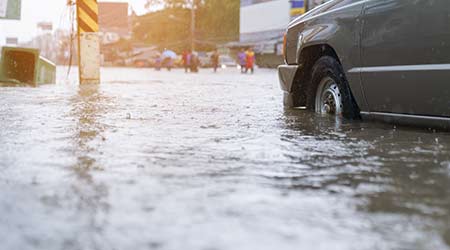« Back to Facilities Management Emergency Preparedness Category Home
Pest Control Essential for Facilities After a Natural Disaster
March 23, 2018
- Emergency Preparedness
By Glen Ramsey
From hurricanes and tornados to floods and fires, natural disasters have unlimited reach and lasting effects. So it goes without saying that the added responsibility of fighting off pests after the devastation of a natural disaster can be a pain point for any property manager. To get ahead of pest populations as a result of a natural disaster situation, it’s important to know the types of natural disasters that could impact a facility in addition to the resulting pest pressures. Once you understand what a facility is up against, you can create an emergency preparedness plan.
To get started, it’s important to have an integrated pest management (IPM) program in place. IPM strategies focus on exclusion, maintenance, and sanitation as methods to control pest populations, using chemical treatments as a last resort. Implementing these strategies can help keep pests out before, during and after a natural disaster. It’s important to make sure that you adjust your IPM program based on your location throughout the year, and as the seasons change.
Locality and Seasonality
No matter your location, there are threats that can make your property attractive for pests.
For Southeastern states, hurricane season can lead to rising water levels. And just like humans, pests want to stay dry during such a disaster so it’s likely they’ll seek out your facility to escape flooding, especially if your building is located on high ground. For Western states, wildfires are a frequent threat, so being prepared for an influx of pests running from the scorched earth should be a priority. In Northern states, snow and freezing temperatures can drive pests indoors as they try to keep warm.
Furthermore, seasons play an important role in preparedness practices as different disasters are triggered by various seasonal elements. With summer comes more wildfires and floods, while winter introduces more blizzards and cold temperatures. Tornado season can bring destruction from early spring to late summer, depending on where you live. So taking notice of the time of year may seem like an obvious step, but it remains an important one when preventing a building from becoming a sanctuary for pests trying to escape the elements.
Identifying the pests
Once you’ve identified which natural disasters are threats to your facility, you need to understand which pests are most likely to encroach on the space. Here are a few pests to watch out for, and tips on how to avoid them:
• Ants can move their entire colony when disturbed. Carpenter ants are known to make their home in wet or rotting wood, often invading their new residence en masse. They can effortlessly burrow their way through damaged fences, fallen tree branches, and any other damaged wood near a facility. Fire ants are also survivalists during floods. They seek higher ground to escape the rising waters, but if shelter can’t be found, they can bond together in the thousands to create a floating “raft” to survive the water. A fire ant sting can be extremely painful, so preventing ant piles from growing around a facility should be a top priority.
Tip: Routinely check facility grounds for ant mounds. If one is spotted, use safe measures to eliminate a potential encounter.
• Cockroaches are attracted to the trash and litter left behind after a disaster. Roaches love warm, damp, and dark conditions. They are also expert hiders — so seeing one during the day can mean many more are hidden in the walls.
Tip: Daily sanitization of a building can help prevent roaches from lingering around before a disaster happens. Drains are a hot spot for roaches, so take measures to prevent food and residue from building up in the kitchen and bathrooms.
• Mosquitoes love standing water and only need a few inches of it to breed. In addition to irritating the people they bite, mosquitoes can spread harmful diseases like Zika and West Nile viruses.
Tip: Immediately remove standing water or small puddles around a building. Mosquitos can reproduce at an alarming rate, so ensure that employees clean up water spots to help prevent populations from growing. You’ll also want to overturn any empty containers that could fill with water and be sure to clean storm gutters to prevent standing water from accumulating.
• Rodents will search for higher ground and dry land. Damage to a building opens a plethora of locations for displaced rodents to call home. These pests can exacerbate damage to a building and are even known to start fires by chewing on electrical wires.
Tip: Clear debris in and around a facility immediately. Cardboard boxes, broken sheetrock, old equipment, and any other damaged materials offer harbors. Seal holes and cracks in both interior and exterior walls to keep rats and mice out. Clear and trim any overgrowth or damaged vegetation outside of your facility to limit easy shelter for rodents.
After a natural disaster, the last thing that you’ll want to worry about is a pest infestation. So do what you can ahead of time to defend your facility against pests and include pest prevention in your plan for responding to the aftermath of a storm. A pest management professional can help you determine the most practical plan for a facility and teach maintenance crews the signs of pest activity and practical, everyday strategies for combatting pest-conducive conditions, before, during, and after a natural disaster.
Glen Ramsey, BCE, is Technical Services Manager for Orkin. He is a board-certified entomologist and provides technical support and guidance across all Rollins brands in the areas of training and education, operations, and marketing. For more information, email gramsey1@rollins.com or visit www.orkincommercial.com.








